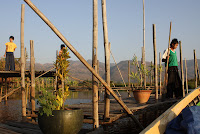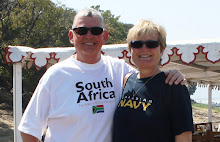 While it was chilly when we boarded the wooden canoe early that morning the freshness was a pleasant change from the heat of Yangon.
While it was chilly when we boarded the wooden canoe early that morning the freshness was a pleasant change from the heat of Yangon. We arranged the blankets around our knees to ward off the damp morning air and were leg rowed away from the dock.
Mist hung over the glassy water, rippling periodically. Birds landed effortlessly and water hyacinth bobbed rhythmically in the wake created by our canoe.

 Once we had cleared the channel our leg rower stepped off the boat at his house which seemed to be occupied by more languid Burmese cats than people.
Once we had cleared the channel our leg rower stepped off the boat at his house which seemed to be occupied by more languid Burmese cats than people. Engine engaged, we picked up speed and soon found ourselves superimposed on everyday life on the lake.
Engine engaged, we picked up speed and soon found ourselves superimposed on everyday life on the lake.  Fishers checked their nets and sunken baskets from wooden skiffs barely wide or deep enough to support them.
Fishers checked their nets and sunken baskets from wooden skiffs barely wide or deep enough to support them. Boats were manoeuvred with incredible dexterity using the leg rowing method.
We stopped to talk to fishers, some of whom had slept overnight on the water in order to secure their catch of Inle carp, a staple of the local diet.

The “fish broker” was holding informal court in a collection of boats as tired fishers presented their catch for payment, the broker destined for the five-day market which rotates between the various lakeside communities. Serious horse trading was underway with fish and kyat, the Burmese currency, rapidly changing hands.

One fisher, cash in hand, stoked a small charcoal fire in a makeshift metal grate on his canoe to extract any remaining heat from the dying embers. He seemed satisfied with the morning’s proceedings.
In addition to fishing, the people of Inle Lake are able farmers, growing vegetables and fruit on extensive floating gardens. The garden beds, anchored by bamboo poles, are created from the nutrient-rich vegetation extracted from the lake bottom. The gardens rise and fall as the water level changes, making them resistant to flooding.


No comments:
Post a Comment